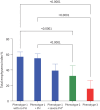Pulmonary hypertension associated with COPD: a phenotype analysis
- PMID: 40129550
- PMCID: PMC11931555
- DOI: 10.1183/23120541.00716-2024
Pulmonary hypertension associated with COPD: a phenotype analysis
Abstract
Background: Pulmonary hypertension (PH) associated with COPD (PH-COPD) exhibits diverse phenotypes, challenging therapeutic management. This study aimed to describe the characteristics of COPD patients with distinct phenotypes, namely end-stage COPD with or without PH (group 1), other COPD patients with mild-to-moderate pre-capillary PH-COPD (group 2) and COPD patients with a pulmonary vascular phenotype (PVP) (group 3).
Methods: We performed a retrospective analysis of COPD patients who underwent right heart catheterisation from 2015 to 2022.
Results: 81 patients were included in group 1, 37 in group 2 and 35 in group 3. The groups differed in terms of clinical, functional, haemodynamic and imaging characteristics. Group 1 had significantly marked lung hyperinflation with increased total lung capacity and residual volume, a feature not observed in group 3. These results were confirmed by analysis of chest CT scans, which confirmed varying degrees of emphysema, as follows: severe in group 1, moderate in group 2 and mild in group 3, with median total emphysema indices of 55% (48-62), 32% (16-49) and 16% (3.4-31), respectively, p<0.0001.
Conclusions: Our results highlight the broad spectrum of PH in COPD, from PH associated with end-stage COPD (phenotype/group 1), characterised by predominant alveolar wall damage with severe emphysema, to PVP (phenotype/group 3), mainly due to pulmonary vascular changes. Phenotype/group 2 represents an intermediate state combining features of both. In the current debate on how to distinguish PH-COPD phenotypes, it might be of interest to include quantitative thresholds for emphysema in future diagnostic and management algorithms.
Copyright ©The authors 2025.
Conflict of interest statement
Conflict of interest: M. Riou discloses honoraria for presentations from Boehringer Ingelheim, Chiesi, Menarini and MSD. Conflict of interest: M. Canuet discloses honoraria for presentations from Menarini and MSD. Conflict of interest: G. Martin discloses honoraria for presentations from GlaxoSmithKline. Conflict of interest: I. Enache discloses honoraria for presentations from Chiesi and payment for expert testimony from AstraZeneca. Conflict of interest: A. Chaouat discloses consulting fees from Chiesi and France Oxygène, and honoraria for presentations from AstraZeneca and MSD. Conflict of interest: R. Kessler discloses honoraria for presentations from GlaxoSmithKline. Conflict of interest: D. Montani discloses grants or contracts to his institution from Acceleron, Janssen and Merck MSD; consulting fees from Acceleron, Merck MSD, Janssen and Ferrer; and honoraria for presentations from Bayer, Actelion/Janssen, Boehringer Ingelheim, Chiesi, GlaxoSmithKline, Ferrer and Merck MSD; and is an associate editor of this journal. Conflict of interest: The other authors declare no conflict of interest.
Figures





References
-
- Global Initiative for Obstructive Lung Disease . 2024 GOLD report. Date last accessed: 15 June 2024. Date last updated: 2024. https://goldcopd.org/2024-gold-report/
LinkOut - more resources
Full Text Sources
